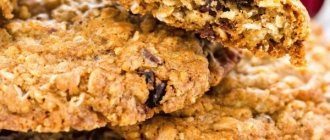Calorie content Nuts with condensed milk. Chemical composition and nutritional value.
Nutritional value and chemical composition of “Nuts with condensed milk.”
The table shows the nutritional content (calories, proteins, fats, carbohydrates, vitamins and minerals) per 100 grams of edible portion.
| Nutrient | Quantity | Norm** | % of the norm in 100 g | % of the norm in 100 kcal | 100% normal |
| Calorie content | 270 kcal | 1684 kcal | 16% | 5.9% | 624 g |
| Squirrels | 3.2 g | 76 g | 4.2% | 1.6% | 2375 g |
| Fats | 11.9 g | 56 g | 21.3% | 7.9% | 471 g |
| Carbohydrates | 38.5 g | 219 g | 17.6% | 6.5% | 569 g |
| Organic acids | 0.7 g | ~ | |||
| Alimentary fiber | 1.5 g | 20 g | 7.5% | 2.8% | 1333 g |
| Water | 12.4 g | 2273 g | 0.5% | 0.2% | 18331 g |
| Ash | 0.5 g | ~ | |||
| Vitamins | |||||
| Vitamin A, RE | 182 mcg | 900 mcg | 20.2% | 7.5% | 495 g |
| Retinol | 0.165 mg | ~ | |||
| beta carotene | 0.115 mg | 5 mg | 2.3% | 0.9% | 4348 g |
| Vitamin B1, thiamine | 0.09 mg | 1.5 mg | 6% | 2.2% | 1667 g |
| Vitamin B2, riboflavin | 0.08 mg | 1.8 mg | 4.4% | 1.6% | 2250 g |
| Vitamin E, alpha tocopherol, TE | 0.9 mg | 15 mg | 6% | 2.2% | 1667 g |
| Vitamin RR, NE | 4.6 mg | 20 mg | 23% | 8.5% | 435 g |
| Niacin | 0.6 mg | ~ | |||
| Macronutrients | |||||
| Potassium, K | 156 mg | 2500 mg | 6.2% | 2.3% | 1603 g |
| Calcium, Ca | 30 mg | 1000 mg | 3% | 1.1% | 3333 g |
| Magnesium, Mg | 11 mg | 400 mg | 2.8% | 1% | 3636 g |
| Sodium, Na | 79 mg | 1300 mg | 6.1% | 2.3% | 1646 g |
| Phosphorus, P | 62 mg | 800 mg | 7.8% | 2.9% | 1290 g |
| Microelements | |||||
| Iron, Fe | 1.4 mg | 18 mg | 7.8% | 2.9% | 1286 g |
| Digestible carbohydrates | |||||
| Starch and dextrins | 25.3 g | ~ | |||
| Mono- and disaccharides (sugars) | 26.8 g | max 100 g | |||
| Sterols (sterols) | |||||
| Cholesterol | 105 mg | max 300 mg | |||
| Saturated fatty acids | |||||
| Saturated fatty acids | 18 g | max 18.7 g |
Hazelnuts - calorie content, nutritional value and chemical composition
The energy value or calorie content of hazelnuts is 660 Kcal per 100 g.
Calorie content is the amount of energy that the body will receive if it completely absorbs the product.
Considering that the average daily calorie requirement for a person with moderate activity ranges from 1500-1800 Kcal, hazelnuts can confidently be classified as high-calorie foods.
However, its nutritional value is so high that the question of giving up the nut is not even for people who are on a diet to lose weight. The most important thing is to keep track of the calorie content of your daily diet, and then it will be possible to fit a couple of nuts in there.
In this article we will look at the calorie content of hazelnuts per 100 g, as well as per 1 nut. You will find out the amount of vitamins, micro and macroelements, proteins, fats and carbohydrates it contains. Get acquainted with the composition and beneficial properties of the product, learn how to use it correctly. Let's start with calories!
Number of calories
First, let's find out how many calories are in hazelnuts in standard measurement, that is, per 100 grams.
Hazelnuts and hazelnuts should be separated. Both options are varieties of the hazel plant, but the first is wild, the second is cultivated.
The nutritional value of domestic nuts is slightly higher than wild ones, but not by much. Wild fruits are bitter and tart; in addition, they are small and more difficult to collect.
So, how many calories are in 100 grams of hazelnuts, let's look at the numbers:
- The calorie content of raw hazelnuts is 660 Kcal per 100 g.
This is approximately 35-50 nuts, depending on the size (there are larger or smaller varieties). The average weight of 1 nut is 2 grams. Based on these data, let's try to calculate how many calories are contained in 1 piece of hazelnut:
- The average calorie content of 1 nut is 13 Kcal.
When creating a diet, other calculated data may be useful to you:
- Calorie content of fried hazelnuts – 710 Kcal per 100 g;
- Calorie content of dried hazelnuts – 680 Kcal per 100 g.e.
We also recommend: Svan salt
Amount of proteins, fats and carbohydrates
We figured out how many calories are in hazelnuts, but to properly build a diet, it is also important to know the nutritional value in terms of BZHU. Let's give the numbers for an ordinary nut that is not subject to any processing.
100 g contains:
- Protein – 16 g;
- Fats – 65 g;
- Carbohydrates – 8 g;
- Dietary fiber, water, ash and other elements – 11 g.
Well, in 1 nut:
- Protein – 0.33 g;
- Fats – 1.34 g;
- Carbohydrates – 0.2 g;
- Other elements – 0.23 g.
This is what the ratio of BJU in hazelnuts looks like, you can safely plan your diet. Nuts are very nutritious and are good to use as a healthy and energy-rich snack. In addition, they contain a lot of useful micro and macroelements.
Composition and beneficial properties
We’ve sorted out the hazelnut KBJU, now let’s list the remaining components that the product is rich in:
- Vitamin B complex;
- Vitamins A, K, E, C, PP;
- Alpha Carotene, Beta Carotene;
- Betaine;
- Among the macroelements, we note potassium, calcium, magnesium, sulfur and phosphorus;
- Microelements include iron, manganese, copper, selenium, zinc;
- Digestible carbohydrates, a whole complex of essential and non-essential amino acids, sterols;
- Fatty acids: palmitic, stearic, arachidic, linoleic, Omega-3, 6, 9.
We also recommend: How to store walnuts
The list is impressive, isn't it. Now, let's find out what benefit we get from all this.
- Due to the high content of B vitamins, regular consumption of this nut has a positive effect on the nervous system. Their deficiency also leads to disruption of the heart, vascular and digestive systems;
- The product reduces cholesterol, increases hemoglobin, improves blood composition;
- It has the property of thinning the blood, and therefore nuts are prescribed for varicose veins, thrombophlebitis and other vascular diseases;
- Antioxidants, which are in abundance in our nut, turn it into an effective anti-aging agent;
- The product strengthens the immune system, helps in the fight against inflammation, infections and even bad tumors;
- The nut has anti-carcinogenic properties and is prescribed to people with cancer;
- The small-looking nut perfectly strengthens bones and muscles, makes ligaments and joints more elastic;
- Helps crush and dissolve kidney stones;
- Improves the quality of breast milk;
- Positively affects the potency and composition of sperm;
- Hazel fruits are protein-rich foods; they can even replace a piece of meat.
We looked at the nutritional value of hazelnuts per 100 grams, as well as its calorie content. As you can see, the product is very healthy, but extremely high in calories. If you do not want to harm either your diet or your health, it should be consumed thoughtfully and in moderation.
- For people engaged in heavy physical labor, the nut will be an excellent fuel and source of energy. If you plan to unload the carriage or move from fifth to fifth (including carrying furniture), feel free to put a generous handful in your pocket;
- If you lead a sedentary lifestyle, and all planned physical activity comes down to carrying your body from the office to the elevator, then to the car and home to the sofa, your measure is 5 nuts;
- The ideal amount of nuts per day for a person with moderate physical activity is 25 g;
- If you are on a diet and planning a healthy snack, you are allowed to eat 6-8 nuts. This snack is best enjoyed in the first half of the day;
- It is better not to fry the product, not to salt it or sweeten it. Eat it raw, you can lightly dry it - this will give you more benefits and less calories;
- Hazelnuts go perfectly with dried fruits and berries and are better absorbed if they are pre-soaked in cold water for a couple of hours.
We also recommend: How to prepare rosehip decoction
Excessive consumption of the product is fraught with headaches, constipation, bloating, and allergic reactions. Never eat nuts with mold - this is an extremely dangerous carcinogenic compound.
In conclusion, let's make a small conclusion. Due to their high calorie content, the body's need for nuts can be easily satisfied with small quantities. Rest assured, this is enough to get pleasure, satisfy your hunger, and also fully absorb the vitamin and mineral complex. Everything is good in moderation!
Source: https://specii-pripravi.ru/funduk-kaloriinost-na-100-gramm-bzhu/
Calorie content Nuts with condensed milk. Chemical composition and nutritional value.
Nuts with condensed milk are rich in vitamins and minerals such as: vitamin A - 32%, vitamin B1 - 13.7%, vitamin B2 - 20%, choline - 22.9%, vitamin B5 - 12.5%, vitamin B9 - 18 .8%, vitamin B12 - 13%, vitamin D - 14%, vitamin E - 19%, vitamin K - 20.4%, phosphorus - 14.9%, iron - 11.2%, selenium - 43.6%
- Vitamin A is responsible for normal development, reproductive function, skin and eye health, and maintaining immunity.
- Vitamin B1 is part of the most important enzymes of carbohydrate and energy metabolism, providing the body with energy and plastic substances, as well as the metabolism of branched amino acids. A lack of this vitamin leads to serious disorders of the nervous, digestive and cardiovascular systems.
- Vitamin B2 is involved in redox reactions, helps to increase the color sensitivity of the visual analyzer and dark adaptation. Insufficient intake of vitamin B2 is accompanied by impaired condition of the skin, mucous membranes, and impaired light and twilight vision.
- Choline is part of lecithin, plays a role in the synthesis and metabolism of phospholipids in the liver, is a source of free methyl groups, and acts as a lipotropic factor.
- Vitamin B5 is involved in protein, fat, carbohydrate metabolism, cholesterol metabolism, the synthesis of a number of hormones, hemoglobin, promotes the absorption of amino acids and sugars in the intestines, and supports the function of the adrenal cortex. A lack of pantothenic acid can lead to damage to the skin and mucous membranes.
- Vitamin B9 as a coenzyme is involved in the metabolism of nucleic acids and amino acids. Folate deficiency leads to disruption of the synthesis of nucleic acids and proteins, resulting in inhibition of cell growth and division, especially in rapidly proliferating tissues: bone marrow, intestinal epithelium, etc. Insufficient folate intake during pregnancy is one of the causes of prematurity, malnutrition, and congenital deformities and child development disorders. A strong relationship has been shown between folate and homocysteine levels and the risk of cardiovascular disease.
- Vitamin B12 plays an important role in the metabolism and transformation of amino acids. Folate and vitamin B12 are interconnected vitamins that are involved in hematopoiesis. A lack of vitamin B12 leads to the development of partial or secondary folate deficiency, as well as anemia, leukopenia, and thrombocytopenia.
- Vitamin D maintains calcium and phosphorus homeostasis and carries out the processes of bone tissue mineralization. A lack of vitamin D leads to impaired metabolism of calcium and phosphorus in the bones, increased demineralization of bone tissue, which leads to an increased risk of developing osteoporosis.
- Vitamin E has antioxidant properties, is necessary for the functioning of the gonads and heart muscle, and is a universal stabilizer of cell membranes. With vitamin E deficiency, hemolysis of erythrocytes and neurological disorders are observed.
- Vitamin K regulates blood clotting. A lack of vitamin K leads to an increase in blood clotting time and a decreased level of prothrombin in the blood.
- Phosphorus takes part in many physiological processes, including energy metabolism, regulates acid-base balance, is part of phospholipids, nucleotides and nucleic acids, and is necessary for the mineralization of bones and teeth. Deficiency leads to anorexia, anemia, and rickets.
- Iron is part of proteins with various functions, including enzymes. Participates in the transport of electrons and oxygen, ensures the occurrence of redox reactions and activation of peroxidation. Insufficient consumption leads to hypochromic anemia, myoglobin deficiency atony of skeletal muscles, increased fatigue, myocardiopathy, and atrophic gastritis.
- Selenium is an essential element of the antioxidant defense system of the human body, has an immunomodulatory effect, and is involved in the regulation of the action of thyroid hormones. Deficiency leads to Kashin-Beck disease (osteoarthritis with multiple deformities of the joints, spine and limbs), Keshan disease (endemic myocardiopathy), and hereditary thrombasthenia.








